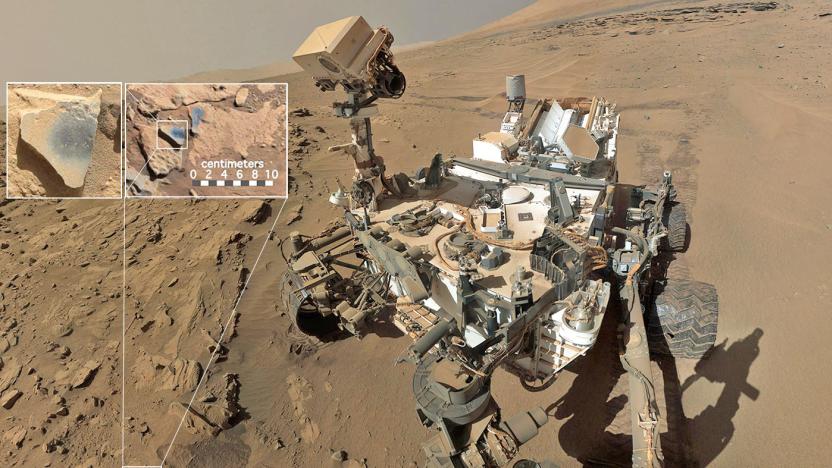Oxygen
Latest

Samsung's latest experiments include a phone app to calibrate your TV
Samsung has unveiled its latest crop of C-Lab experiments, including a phone app that calibrates your TV and a scanner that helps you clean clothes.
Jon Fingas01.06.2021
Study says climate change is starving the oceans of oxygen
The effect of climate change on oceans is likely more extensive than you think. A study from the International Union for Conservation of Nature (IUCN) indicated that climate change and the ensuing hotter water reduced the amount of oxygen dissolved into oceans by 2 percent between 1960 and 2010. While that may seem like only a modest amount, oxygen levels in some tropical regions dropped by up to 40 percent. Moreover, scientists warned that even a slight dip could be particularly troublesome for big, energy-dependent fish like marlin, sharks and tuna. Lower oxygen levels drive them to shallower water, putting them at greater risk of overfishing.
Jon Fingas12.08.2019
New solar cell generates hydrogen and electricity at the same time
In the ongoing pursuit of abundant, renewable alternatives to fossil fuels, scientists have produced hydrogen for fuel cells through artificial photosynthesis, which splits water into hydrogen and oxygen. Traditional processes have struggled to use optical, electronic and chemical properties in a way that makes this method efficient, but now researchers from Berkeley Lab have created a recipe that could completely bypass the limitations in current materials.
Rachel England10.30.2018
Mars may have enough oxygen underneath its surface for life
The possibility of life on Mars has been a tantalizing possibility for years, and recent discoveries have only increased excitement about whether we'll find life on the red planet. Now, a new study in Nature Geoscience posits that it's possible that Mars may have enough oxygen to harbor life under its surface.
Swapna Krishna10.22.2018
OnePlus 5 review: Making the leap from good to great
We've been following OnePlus and its journey to build a better flagship phone for years. Along the way, it managed a feat that's difficult for even the biggest conglomerates: The company kept outdoing itself. I don't mean to spoil the fun here, but the team has done it again with the OnePlus 5. Really, what's most striking is just how much this tiny company managed to get right in a phone that costs less than $550 (more on that later). It might not have every single whiz-bang feature that you'll find in other flagship smartphones, but the thoughtful balance of style, power and price make it a star.
Chris Velazco06.20.2017
Close-by exoplanet may have an oxygen-rich atmosphere
At last, scientists might have spotted a rocky exoplanet with an oxygen-heavy atmosphwere... only it's not the alternate Earth you might be hoping for. Astronomers have determined that GJ 1132b (aka Gliese 1132b), a relatively close 39 light years away, stands a real chance of having oxygen-rich skies. However, it's also scorching hot at 450F (232C). With that kind of heat, any water vapor would have a greenhouse effect -- the atmosphere would cook the surface (turning it into a magma ocean) and eliminate any hope of life.
Jon Fingas08.22.2016
Curiosity finds evidence that Mars was once rich in oxygen
Mars may have had a much more Earth-like atmosphere rich in oxygen, according to JPL's Curiosity team. Using its laser-firing instrument in the Gale Crater, the intrepid rover found rocks with manganese oxide, which requires oxygen to form. On Earth, such minerals marked a period when our atmosphere became much more oxygen-rich, largely because of microbes. "Now we're seeing manganese oxides on Mars, and we're wondering how the heck these could have formed," says Los Alamos scientist Nina Lanza.
Steve Dent06.28.2016
Unique white dwarf will help clarify what happens to dying stars
Researchers have discovered a white dwarf (a dead star), with an oxygen atmosphere surrounding it -- the first of its kind. Astronomers managed to pick up the star from spectral lines: colored trails that help show the composition of distant stars. Most white dwarfs have hydrogen or helium in their atmosphere, but this one was giving off a shade that corresponded to almost pure oxygen.
Mat Smith04.01.2016
Turning sunlight into clean fuel is now cheap and simple
Scientists have already produced artificial photosynthesis, but it has been an exotic process until now. You aren't about to replace the oxygen-giving plants around your home, in other words. However, researchers at Florida State University researcher have found a way to make it practical. They've developed a single-layer manganese oxide material that efficiently traps sunlight and makes it easy to break down that energy into hydrogen and oxygen. Current light-gathering techniques, like solar cells, frequently need multiple layers just to work at all -- this would be far cheaper and simpler to make.
Jon Fingas11.29.2015
Astronomers find pure oxygen leaking from Rosetta's comet
European Space Agency astronomers, with the help of the Rosetta spacecraft, have made a remarkable discovery that could fundamentally alter our understanding of how the solar system formed. They have detected large amounts of pure oxygen (O2) leaking from comet 67P/Churyumov-Gerasimenko. Oxygen is a pretty common element, but because it reacts so easily with other elements it's almost always found in mixed molecules like carbon monoxide (CO), carbon dioxide (CO2) or water (H2O).
Andrew Tarantola10.28.2015
OnePlus 2 review: a worthy sequel, flaws and all
I don't envy the team at OnePlus. After shipping a smartphone that made us rethink what we could get -- nay, what we deserved -- for $299, it was tasked with building an even better follow-up. If this were some schlocky '80s, teen coming-of-age film, it'd be time for a montage, but here we are a year later with a more confident, experienced startup and a new device that still promises to "never settle." At $329 for the basic 16GB model (or $389 for the 64GB version), the new OnePlus 2 isn't quite as wallet-friendly as the phone we got last year, and more than a few rivals have since come out with low-cost, high-power phones of their own. So, did OnePlus do the impossible again? Did it actually create a worthy sequel to a fan-favorite device, amid crazy competition in the world of cheap, fantastic unlocked phones? Well, yes, but it's not without its flaws.
Chris Velazco08.19.2015
Herschel telescope finds first evidence of oxygen molecules in space
It's not every day that scientists get to say they've found something in space for the first time ever, but astronomers working with the European Space Agency's Herschel Space Observatory announced just such a discovery today, and it's a big one. They've made the first confirmed finding of oxygen molecules in space (found hiding in the Orion nebula), and suggest that the oxygen is likely released when the water ice surrounding dust grains is melted by the heat from nearby stars forming. Of course, one discovery only leads to more questions, and the scientists note that they still haven't found large amounts of oxygen, and "still don't understand what is so special about the spots where we find it."
Donald Melanson08.01.2011
NASA collects proposals for space fueling stations
Sometimes rocket science is actually, you know, rocket science. Getting to the moon was tough enough, but deep space exploration poses all manner of additional concerns -- like getting back home alive, for one thing. And then there's the issue of fuel, something long distance trips require a lot of -- but stocking up on here on Earth means potential weight problems at launch. One proposal offered up in the past is space-based fueling stations conveniently located in key spots on the way to a distant destinations like the Moon, Mars, and asteroids. NASA is collecting proposals that can demonstrate the validity of such a plan, including the ability to store liquid oxygen and hydrogen, transfer it, and have a ship approach for fueling. If you think you've got your bases covered -- and can keep it under $200 million -- you've got until May 31st at 11:59 PM EST to hand over a proposal.
Brian Heater04.28.2011
Oxygen Audio debuts O'Car, O'Dock iPhone car docking accessories
Looking for a bit more integration than your usual iPhone car dock or FM transmitter can provide? Then you might want to consider Oxygen Audio's new O'Car head unit, which packs a swiveling iPhone dock that's considerably discreet than some other similar units out there. It's also, of course, a full-fledged car radio, and it packs a 4x55W amp that Oxygen says delivers "perfect quality sound" to your car's speakers. If that's all a bit too much for you, however, Oxygen has also announced the decidedly more standard-looking O'Dock unit that simply mounts on your dash or windshield -- check it out after the break. Unfortunately, there's still no word on pricing or availability for either unit, but we're assuming those details will be made available at CES next month.
Donald Melanson12.16.2010
The Bloom Box: a power plant for the home (video)
Those two blocks can power the average high-consumption American home -- one block can power the average European home. At least that's the claim being made by K.R. Sridhar, founder of Bloom Energy, on 60 Minutes last night. The original technology comes from an oxygen generator meant for a scrapped NASA Mars program that's been converted, with the help of an estimated $400 million in private funding, into a fuel cell. Bloom's design feeds oxygen into one side of a cell while fuel (natural gas, bio gas from landfill waste, solar, etc) is supplied to the other side to provide the chemical reaction required for power. The cells themselves are inexpensive ceramic disks painted with a secret green "ink" on one side and a black "ink" on the other. The disks are separated by a cheap metal alloy, instead of more precious metals like platinum, and stacked into a cube of varying capabilities -- a stack of 64 can power a small business like Starbucks. Now get this, skeptics: there are already several corporate customers using refrigerator-sized Bloom Boxes. The corporate-sized cells cost $700,000 to $800,000 and are installed at 20 customers you've already heard of including FedEx and Wal-mart -- Google was first to this green energy party, using its Bloom Boxes to power a data center for the last 18 months. Ebay has installed its boxes on the front lawn of its San Jose location. It estimates to receive almost 15% of its energy needs from Bloom, saving about $100,000 since installing its five boxes 9 months ago -- an estimate we assume doesn't factor in the millions Ebay paid for the boxes themselves. Bloom makes about one box a day at the moment and believes that within 5 to 10 years it can drive down the cost to about $3,000 to make it suitable for home use. Sounds awfully aggressive to us. Nevertheless, Bloom Energy will go public with details on Wednesday -- until then, check the 60 Minutes sneak peek after the break. [Thanks, Abe P.]
Thomas Ricker02.22.2010
EA's Board of Directors breathes in Oxygen founder
Geraldine Laybourne, the founder of women's cable television channel Oxygen, has joined the Board of Directors at Electronic Arts. Prior to creating television programs that pander to the fairer sex, Laybourne also worked for Nickelodeon, where she was instrumental in launching the station's window into the past that is Nick at Night. While it's pure guesswork as to whether this move was more driven by Laybourne's business savvy or EA's continued interest in putting games in front of women, families and tweens, we imagine that both played a vital role in getting the TV exec to hop on board.
Jason Dobson11.07.2008
CNU's oxygen emitting robotic plants: deforestation solved
When the earth warms and the forests turn to dust, at least the robots will remain to re-oxygenate the Earth. The Chonnam National University developed robotic plant (pictured above holding a human child puppet) from Korea stands over four-feet tall; consists of a pot, stem, and five meat-eating buds; and emits oxygen, moisture, and even an aroma of human effluence, we presume. As people approach the "flower," the robot bends towards the person and begins to bloom and slightly shake in response to the startled victim's voice rising from a mute whimper to an alarmist howl. The robot also responds to music and light by dancing and opening and closing its petals in some kind of victory celebration. Project leader Park John-oh suggests building a robot garden from his creation -- sure, we'll get right on that just as soon as we get our Doomsday Machine back on-line.[Via Hallyu Technology]
Thomas Ricker10.16.2008
Video: MIT develops solar storage "nirvana": energy crisis solved?
MIT is in a twisted, propeller-capped knot this morning heralding a new discovery it says will unleash a solar revolution. However, the "revolutionary leap" inspired by photosynthesis is not on the glamorous front-end of energy collection, rather, it's related to a simple, highly efficient and inexpensive way to store that energy when the sun doesn't shine. "This is the nirvana of what we've been talking about for years," says Daniel Nocera, MIT neomaxizoomdweebie who with Matthew Kanan developed the unprecedented approach to split water into hydrogen and oxygen gases using the sun's energy. The gases can then be recombined later inside a fuel cell. The key components to the process are a pair of catalysts (one consists of cobalt metal, phosphate, and an electrode; the other, platinum) which produce the O and H gases at room temperature and in neutral pH water (i.e., tap water). While similar solutions exist for industrial use (primarily), these are very expensive and require specialized environments. "This is a major discovery with enormous implications for the future prosperity of humankind," said James Barber, a leader in the study of photosynthesis at Imperial College in London. "The importance of their discovery cannot be overstated since it opens up the door for developing new technologies for energy production thus reducing our dependence for fossil fuels and addressing the global climate change problem." Nocera concedes that further engineering is required to commercialize the approach but hopes to see it implemented in household fuel cell systems within the next 10 years. Click through for the video breakdown.
Thomas Ricker08.01.2008
VC Monday Madness: Super Fantasy Zone, Gley Lancer and Pirates
After all of the fun to be had at E3, it's time to get back to business as usual. Nintendo knows this, which is why the Virtual Console and WiiWare have both updated this week. So, let's get to the details already!This week's WiiWare release is: Pirates: The Key of Dreams (1-4 players, 1,000 Wii Points) This week's Virtual Console releases are: Super Fantasy Zone (Sega Genesis, 1 player, 900 Wii Points) Gley Lancer (Sega Genesis, 1 player, 900 Wii Points) And, before you ask, yes, those are the correct prices (both games are imports).[Via press release]
David Hinkle07.21.2008
VC Friday: 'Arrrr's and cars
It's a double WiiWare update for this Friday, PAL peeps. Oxygen's Pirates: The Key of Dreams is an unknown quantity, but appears to be some kind of piracy-themed scrolling shooter with strategic elements. If that sounds like it has potential, the footage we've seen so far (viewable, as usual, after the break) isn't filling us with bright-eyed optimism. We'll be downloading that today and giving it a whirl, so let's hope we're wrong!SPOGS Racing, on the other hand, is very much a known quantity, and not a very great one, either -- we slapped a three out of ten on it. Pirates: The Key of Dreams -- WiiWare -- 1000 Wii Points SPOGS Racing -- WiiWare -- 1000 Wii Points
Chris Greenhough07.18.2008